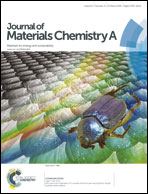Ni/CdS/TiO2 nanotube array heterostructures for high performance photoelectrochemical biosensing†
Abstract
A novel photoelectrochemical (PEC) biosensing platform was constructed based on a ternary hybrid Ni/CdS/TiO2 nanotube array electrode, which was fabricated by the combination of electrochemical anodization and electrodeposition. Field emission scanning electron microscopy (FESEM) and transmission electron microscopy (TEM) confirmed that the CdS and Ni nanoparticles were homogeneously dispersed on the TiO2 nanotube arrays. Here, the Ni nanoparticles on the surface of CdS/TiO2 heterojunctions play a dual role in enhancing the performance of the PEC biosensor. First, Ni nanoparticles serve as a hole receptor, which can promote the fast charge separation and act as a protective layer that improves the stability of the Ni/CdS/TiO2 electrode. Second, Ni can remarkably improve the photoelectrochemical performance because it is a highly efficient electrocatalyst. As a result, the Ni/CdS/TiO2 nanotube array electrode offered much enhanced photocurrent compared to the CdS/TiO2 nanotube array electrode. Using glucose as a model, a highly sensitive photoelectrochemical biosensor based on the Ni/CdS/TiO2 nanotube array electrode was developed. Under optimized conditions, the biosensor displayed a wide linear range, a low detection limit as well as high selectivity and good stability. All these results indicate that this novel electrode is a promising candidate for use as a photoelectrochemical biosensor.


 Please wait while we load your content...
Please wait while we load your content...